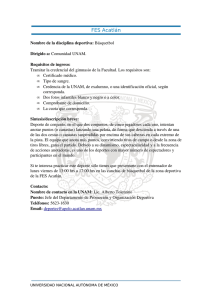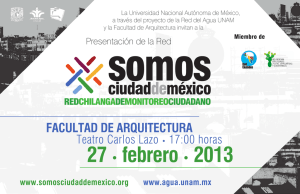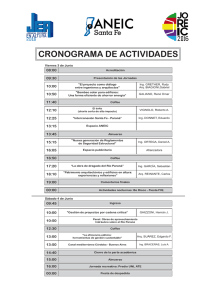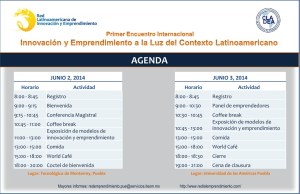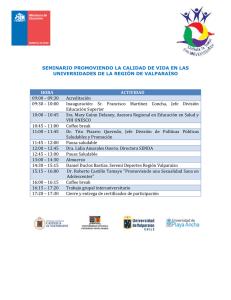RESEÑA BOOK REVIEW
Anuncio
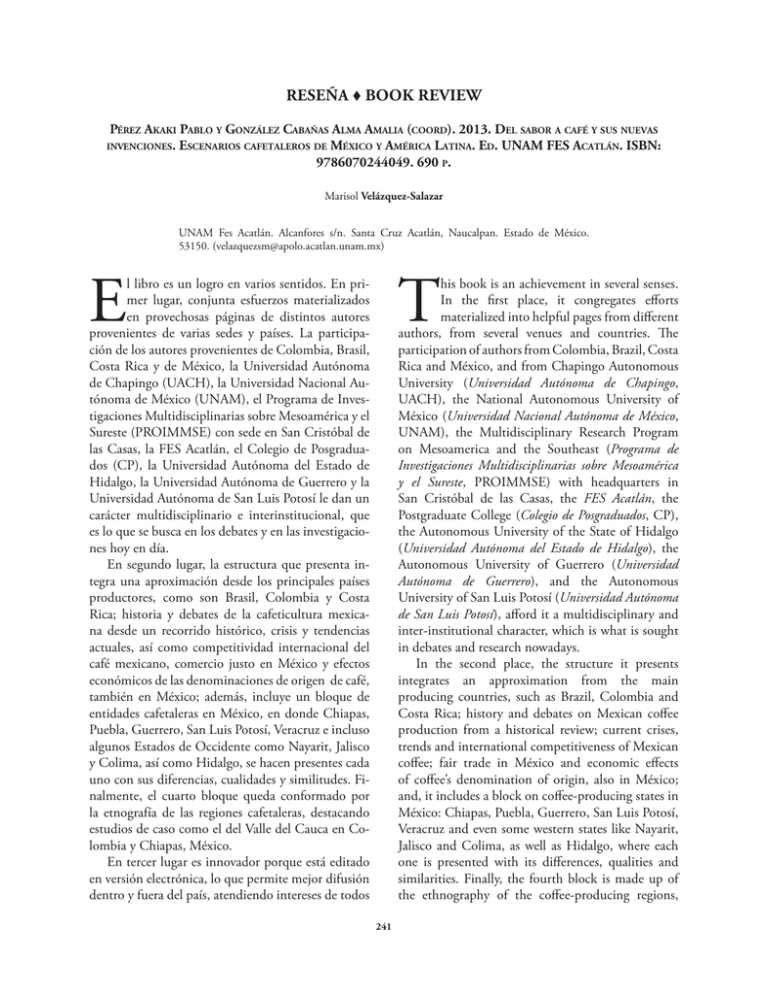
RESEÑA t BOOK REVIEW Pérez Akaki Pablo y González Cabañas Alma Amalia (coord). 2013. Del sabor a café y sus nuevas Escenarios cafetaleros de México y América Latina. Ed. UNAM FES Acatlán. ISBN: 9786070244049. 690 p. invenciones. Marisol Velázquez-Salazar UNAM Fes Acatlán. Alcanfores s/n. Santa Cruz Acatlán, Naucalpan. Estado de México. 53150. ([email protected]) E T l libro es un logro en varios sentidos. En primer lugar, conjunta esfuerzos materializados en provechosas páginas de distintos autores provenientes de varias sedes y países. La participación de los autores provenientes de Colombia, Brasil, Costa Rica y de México, la Universidad Autónoma de Chapingo (UACH), la Universidad Nacional Autónoma de México (UNAM), el Programa de Investigaciones Multidisciplinarias sobre Mesoamérica y el Sureste (PROIMMSE) con sede en San Cristóbal de las Casas, la FES Acatlán, el Colegio de Posgraduados (CP), la Universidad Autónoma del Estado de Hidalgo, la Universidad Autónoma de Guerrero y la Universidad Autónoma de San Luis Potosí le dan un carácter multidisciplinario e interinstitucional, que es lo que se busca en los debates y en las investigaciones hoy en día. En segundo lugar, la estructura que presenta integra una aproximación desde los principales países productores, como son Brasil, Colombia y Costa Rica; historia y debates de la cafeticultura mexicana desde un recorrido histórico, crisis y tendencias actuales, así como competitividad internacional del café mexicano, comercio justo en México y efectos económicos de las denominaciones de origen de café, también en México; además, incluye un bloque de entidades cafetaleras en México, en donde Chiapas, Puebla, Guerrero, San Luis Potosí, Veracruz e incluso algunos Estados de Occidente como Nayarit, Jalisco y Colima, así como Hidalgo, se hacen presentes cada uno con sus diferencias, cualidades y similitudes. Finalmente, el cuarto bloque queda conformado por la etnografía de las regiones cafetaleras, destacando estudios de caso como el del Valle del Cauca en Colombia y Chiapas, México. En tercer lugar es innovador porque está editado en versión electrónica, lo que permite mejor difusión dentro y fuera del país, atendiendo intereses de todos his book is an achievement in several senses. In the first place, it congregates efforts materialized into helpful pages from different authors, from several venues and countries. The participation of authors from Colombia, Brazil, Costa Rica and México, and from Chapingo Autonomous University (Universidad Autónoma de Chapingo, UACH), the National Autonomous University of México (Universidad Nacional Autónoma de México, UNAM), the Multidisciplinary Research Program on Mesoamerica and the Southeast (Programa de Investigaciones Multidisciplinarias sobre Mesoamérica y el Sureste, PROIMMSE) with headquarters in San Cristóbal de las Casas, the FES Acatlán, the Postgraduate College (Colegio de Posgraduados, CP), the Autonomous University of the State of Hidalgo (Universidad Autónoma del Estado de Hidalgo), the Autonomous University of Guerrero (Universidad Autónoma de Guerrero), and the Autonomous University of San Luis Potosí (Universidad Autónoma de San Luis Potosí), afford it a multidisciplinary and inter-institutional character, which is what is sought in debates and research nowadays. In the second place, the structure it presents integrates an approximation from the main producing countries, such as Brazil, Colombia and Costa Rica; history and debates on Mexican coffee production from a historical review; current crises, trends and international competitiveness of Mexican coffee; fair trade in México and economic effects of coffee’s denomination of origin, also in México; and, it includes a block on coffee-producing states in México: Chiapas, Puebla, Guerrero, San Luis Potosí, Veracruz and even some western states like Nayarit, Jalisco and Colima, as well as Hidalgo, where each one is presented with its differences, qualities and similarities. Finally, the fourth block is made up of the ethnography of the coffee-producing regions, 241 AGRICULTURA, SOCIEDAD Y DESARROLLO, ABRIL - JUNIO, 2014 los involucrados en la cadena productiva, desde los productores hasta los transformadores y comercializadores del grano. Casi 700 páginas en las que si uno tiene alguna duda sobre el origen del café, su historia, el comportamiento de los actores de la cadena, cuáles y porqué son los principales países productores, entre otras cuestiones, puede consultarlo no una, sino las veces que sea necesario porque cuando entra al tema del café, al parecer ya nunca se aleja. Uno sigue tratando de averiguar cómo es que esa taza que tomamos en las mañanas despierta tal interés y genera tanta contradicción dentro de un mismo mundo. Porque no solo en México, sino en toda Latinoamérica, los productores tienen características de marginación y pobreza que, aunque son diferentes en cada caso, tienen puntos en común. Asimismo, este estudio comprende dos décadas, lo que permite hacer comparaciones antes y después de la liberalización del mercado que afectó el espacio cafetalero. Uno de los principales objetivos del libro es contribuir al desarrollo de las regiones cafetaleras a partir de la reflexión y la crítica. Otro de los logros de este libro es el hecho de que, además de académico y de consulta, resulta de interés para cualquier consumidor de dicha bebida. Es un trabajo que data desde 2007 y se materializa en 2013, mas no termina. Cada uno de sus capítulos logra adentrarnos al mundo del café, generando más interés y preguntas. Es por la pertinencia del tema en términos de desarrollo regional y sectorial, así como por el placer de saber más sobre café y saborearlo con más conciencia, que recomendamos leer y releer este libro, que conjunta la diversidad que presenta la cadena del grano actualmente. - Fin de la versión en Español - with some study cases that stand out such as one about Valle del Cauca in Colombia, and one about Chiapas, México. In the third place, it is innovating because it is edited in electronic version, allowing a better dissemination within and outside the country, and addressing interests of all those involved in the productive chain, from producers to transformers and traders of the grain. Almost 700 pages where, if one has any question on the origin of coffee, its history, the behavior of the actors in the chain, which and why are the primary producing countries, among other issues; it can be consulted not once, but all the times necessary because once one enters the subject of coffee, apparently you can never depart it. One continues trying to find out how it is that the cup we drink in the mornings awakens such interest and generates such contradiction within the same world. Because it is not only in México, but rather in all of Latin America, where producers have characteristics of marginalization and poverty; although different in each case, they have points in common. Also, this study covers two decades, allowing the authors to make comparisons before and after the liberalization of the market that affected the coffee-producing space. One of the main objectives of the book is to contribute to the development of the coffee regions as a result of reflection and critique. Another one of the achievements of this book is the fact that, in addition to being academic and for consult, it is interesting for any consumer of the beverage. It is a project that dates back to 2007 and is materialized in 2013, although not finished. Each one of its chapters manages to invite us to delve into the world of coffee, generating more interest and questions. Because of the pertinence of the issue, in terms of regional and sectorial development, as well as from the pleasure of knowing more about coffee and tasting it with more conscience, we recommend reading and re-reading this book, which combines the diversity that the chain of the grain currently presents. - End of the English version - 242 VOLUMEN 11, NÚMERO 2
